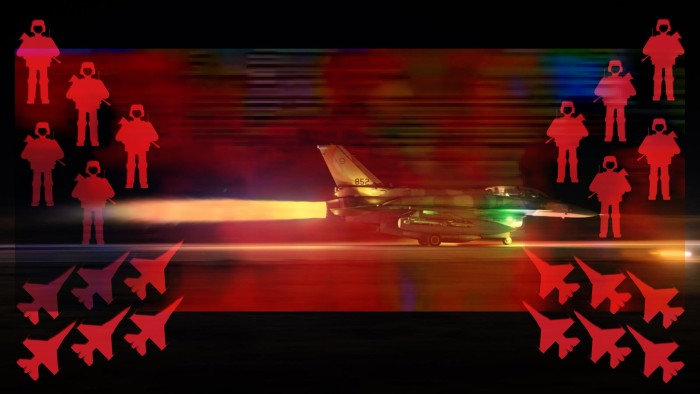Share this @internewscast.com
As Israel gears up for further waves of attacks on Iran, following Donald Trump’s warning that these would be “even more brutal,” leaders in the Islamic Republic have pledged to retaliate.
Major General Mohammad Pakpour, who assumed the role of Iran’s commander of the Revolutionary Guards on Friday, shortly after his predecessor’s assassination, has promised to “open the doors of hell” in response.
However, what can Iran realistically do to effectively deter Israel? Tehran — heavily impacted by years of sanctions, with its primary Shia proxies in the region significantly weakened — views itself as being embroiled in an existential struggle against a regional power empowered by the latest western military technology and strong US backing.
“The Iranians will struggle to muster a meaningful response,” said Dan Shapiro, former deputy assistant secretary of defence for the Middle East at the Pentagon.
Iran’s first salvo of drones was successfully intercepted. On Friday night Iran launched dozens of ballistic missiles, some of which penetrated Israel’s defences to hit buildings in urban areas. Scores were injured and some killed.
The bulk of the missiles were intercepted and the barrages were on a smaller scale than two Iranian retaliatory assaults last year in terms of numbers. But it appeared that Iran had shifted its tactics, launching in successive waves throughout the night and early morning, primarily targeting Tel Aviv, making them more destructive.
Rather than alter the calculus of the conflict, or deter further strikes, the assault prompted Israel to promise further escalation.
“The real dilemma for Iran will be whether to sprint to a nuclear breakout,” said Shapiro, who is also a former US ambassador to Israel. “They may calculate that will give them the deterrence to ensure regime survival — but that also runs the risk of drawing in the US.”
UN inspectors for years have diligently sought to monitor Iran’s nuclear programme and in particular its enrichment of uranium, which can produce both fuel and weapons-grade material. Iran has in recent years expanded its stockpile of near weapons-grade enriched uranium.

It has the capacity to produce sufficient fissile material for a nuclear weapon in less than two weeks, experts say.
The monitoring efforts make it unlikely — but not impossible — that Iran has already secreted away enough fissile material for a single, simple bomb, which would require less than 15kg of enriched uranium. Putting the uranium on a warhead and developing missile capacity are further challenges, but with enough fissile material, Tehran could in theory fashion a so-called “dirty bomb”.
Such drastic steps would have parallels with Israel’s own development of a secret nuclear arsenal, a “doomsday operation”, which evolved into the nuclear doctrine nicknamed the Samson Option.
During the 1967 war, Israeli officials had authorised a plan of last resort to detonate a hastily assembled nuclear device in the Sinai desert, with the aim of freezing the conflict before Arab armies crossed Israeli borders. (In the event, Israel won the war — the plan became public only in 2001.)
Other options are more traditional: attacking Israeli military facilities and diplomatic missions, or carrying out the threat, voiced by some commanders, of hitting US military targets in the Middle East.

Iranian forces could also turn to asymmetric warfare, attempting to shut off or disrupt the Strait of Hormuz, a key waterway separating Iran from the Gulf states, through which almost a third of all global seaborne oil exports flow.
Each carries great risks for Iran, including the potential for spectacular failure or further escalation, with the US stepping in substantially to aid Israel, said a former Israeli official who worked on similar assessments in the past.
Analysts and people familiar with Israel’s defence plans expect Iran to continue to try to overwhelm Israel’s multi-layered aerial defences with a massive wave of drones and missiles. Such attacks could target Israeli nuclear facilities, air bases and other critical infrastructure, such as ports and the airport in Tel Aviv.
That would force Israel to ration its limited supply of interceptor missiles, many of which have had to be replenished on an urgent basis after 20 months of war with Hamas in Gaza, Hizbollah in Lebanon and two barrages from Iran in April and October 2024.
Iran’s barrage on Friday and those two earlier assaults showed Iran’s best missiles could pierce Israeli air defences, even when they were bolstered by an emergency deployment of US and other warplanes intercepting missiles and drones far from Israeli airspace.
Some two dozen missiles landed inside the Nevatim Air Base in southern Israel, satellite images later showed. One landed near the Mossad headquarters in north Tel Aviv. Others hit a second air base.
But two people familiar with that assault said it had also shown the limits of Iran’s capabilities. The damage to the air bases was quickly repaired, no aircraft were damaged and Israeli radar operators trained their algorithms on reams of data gathered during the attack.
An Iranian missile barrage fired at Israel in October was the first time the country’s air defences were so thoroughly tested by a regional power, instead of Hamas’s rockets, which are easily intercepted by the Iron Dome system. But that assault was telegraphed at a time when Iran was seeking to avoid the full-blown conflict with Israel in which it now finds itself. And in both of last year’s attacks Tehran targeted military sites, while this time the targets are broader and across multiple cities and towns.
One of Iran’s goals last year, according to an analysis carried out after the event by Israel’s military intelligence directorate, was to see how successfully a “rapid saturation event” could overwhelm Israel’s defensive systems.

Israel’s military doctrine on rationing interceptors — how many it has at any time is a national secret — takes into account the nature of the attack and the target.
If running low on the missiles, protecting military targets is considered more important, in order to protect the ability to counter-attack, for instance. Fox News on Friday reported the US had replenished a significant amount of the Tamir interceptors Israel used, which are partially manufactured in the US.
Another factor has also constrained Iran: the disruption from the first wave of Israeli strikes, according to Israel. The Israeli Air Force on Friday night hit Iran’s surface-to-surface missile arrays, it said, aiming to blunt any possible counter-attack.
Sima Shine, a former official at Israel’s Mossad intelligence agency who had a focus on Iran, said that would have affected the scale at which Iran would be able to mount an immediate counter-attack.
Iran also needed to take time to take stock after the assassination of senior Iranian officials responsible for military strategy. The military officers were “very vital, very knowledgeable, and had been in their jobs for many years”, she said.
Destroying missile systems is not as complicated as destroying Iran’s underground nuclear facilities, said a former air force pilot who had been trained for similar missions about a decade ago.
“Missile systems require very complex mechanisms to work together,” he said. “To disable the system, you don’t have to destroy it, only hitting a single [crucial] component is enough — the radar, the transport system, even the mechanical systems that position the missile.”
Knowing their location is significantly more useful than the kind of armaments used, he said.
The Israeli air force is expected to make repeated bombing runs in the coming days, and has been destroying Iran’s aerial defences — some of them made locally, others procured from allies such as Russia — to maintain aerial superiority.
That would force Iran to allocate its limited missile systems defensively, said the former pilot, instead of using them to punish Israel.
“It is clear now that our [pilots] can strike at will in Iran,” he said. “This was not always true, and it changes the equation completely.”
Graphic illustrations by Ian Bott and Steven Bernard









